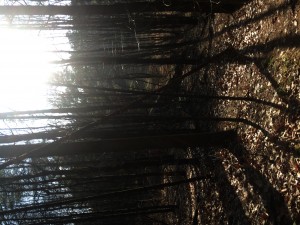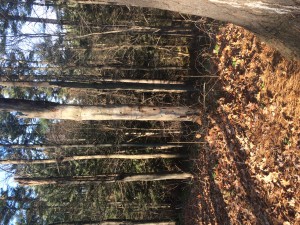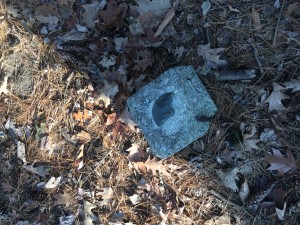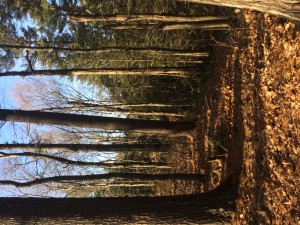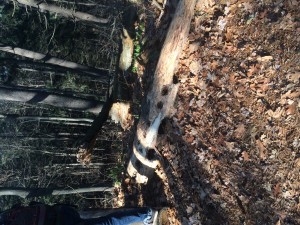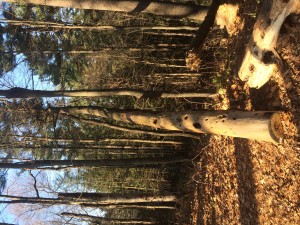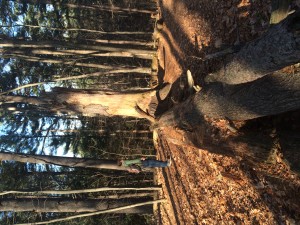My sight is an almost fully natural area that has been saved from the total limitation that human interaction cause on natural sights, however, since the institution of UVM has spared centennial woods from this fate I was lucky enough to spend some time in my phenology blog space. Since centennial woods is a protected natural area that means that most of the space is protected from most human development and influences. However, there are things can be done to increase the security of the sight for natural beings. What can be done is research. A better understanding of a forests, out trees and the animals that live there is the only key to unlocking their potential for the human race and for themselves. Our natural world is currently on the decline. Biodiversity is decreasing constantly; we are losing our trees to infection and to pests. What best we can do for our natural world is to understand everything in it as best as we can before it all disappears. That’s why it is important to maintain areas like centennial woods as best as we can, so that hey can be utilized as the research meccas they were intended to be. Our political economy has allowed us to elect the right people and hear the right voices so that we have been able to hold natural areas like these away from the jaws of destruction that is American capitalism. American capitalism is a asocial construction (or has caused one, I’m not sure if the chicken or the egg came first) that has trained us to think about the natural world in its resources before its inherent value and beauty. The capitalist system has caused greed to cloud our judgment as a people and given us the inhuman power to destroy much of the world from which our life has sprung. Many of my classmates in the forestry program share these ideas. The only thing that it seems that we can do besides changing our system of government and our belief system in the modern world and beyond picking up litter every Sunday seems to be research. If I am successful enough as an academic to get into graduate school and receive a research grant, then me and my class mates as well I trust will go into the field and begin to research ways to save our natural world from destruction by men and the alteration we have made to nature like foreign invasive species so that we as a human race may benefit from the natural a world and so that the place from which our life has sprung, life will spring eternal.
Ethics- My sight seems to be fairly important to people for a number of reasons. First off, there is half of a place marker that’s porpoise is illegible at my sight meaning someone had importance for that specific spot. Secondly I rarely, if ever see trash or severe human disturbance at the sight.
Social Construction- My area has undergone social construction in regards to the fact that it is brought from the idea of conservation which in and of itself is actually a social construction… fascinating.
Posted in Uncategorized | Leave a Comment »
Limits/signs of resource use:
- Some kind of land marker
- Mysterious land marker missing half of its plack is a sign that humans to create resources in the past used the area. Cattle were once grazed and driven where the forest now grows. There were also possibly crops grown in the area at one point in time. The simultaneous nutrient detraction and addition that occurred during this time in the lands history has most definitely had an effect on the ecosystem and the way it works today.
- Large stone wall
- A large stonewall covered in graffiti casts a large area of shade keeping plants from growing and is also an eyesore depreciating from the overall value of the environment
- Wall could also divert water flow, detracting from the naturally occurring events of the ecosystem.
- Cut down trees
- Culling older larger trees can make for an easier early life for saplings helping them to grow and become a new part of the over story by filling in the gap that the old tree left when it was cut down
- Wide foot path/foot traffic
- Our spot on the food chain means our mere presence might have a profound effect on the behavior of the organisms in the area
- The footpath creates a barrier and can limit the connectivity/continuity of the ecosystem
- Noise pollution
- Proximity of my spot to the road and to parking lots could have an effect on the behavior of the ecosystems beings in a similar way to the presence of humans on the area
Institutions and their effect on human behavior:
- Farming community
- The old institution of growing crops and graising cows on the land that centennial woods natural area now occupies is long gone. But it once decided the face of the landscape almost entirely. Grass, crops and manure were all that there was to be found for miles so that farming could take place on the land. These practices ran the early economy of Vermont.
- Research/natural area
- An area for research, and teaching of ecosystem science and education, centennial woods is now being used by the institution of the University of Vermont as a tool that perpetrates the advancement of the environmentalist movement that we may need to save our natural world.
Posted in Uncategorized | Leave a Comment »
I found from research the the 65 acres of woods at Centennial was previously used as an area for grazing farm animals, just like much of Vermont. The switch to academic studied preservation land was made by the university in an attempt to conserve your environment and teach young minds about its importance at the same time. I believe that the soil may have been affected by farm animal feces making it more nutrient rich and better for growing a forest than it would have been had no farm animals ever grazed their.
Posted in Uncategorized | Leave a Comment »
The species of vegetation I was able to identify: Birch, Asch, Maple, Pine, Beech, Mosses, ferns, shrubbery such as Barberry, much of these ground species died off as winter approached.
Species of animal i was able to identify: Fisher Cat, Pileated woodpecker, Common Grey Squirrel, a number of finches and a flacon from time to time.
Posted in Uncategorized | Leave a Comment »
As you can see from my two photo gallery postings the changes in my phenology spot mostly consisted of leaves falling off of trees. Other than that the large dead logs in my area became far more rotted and lost a lot of biomass as time passed. I believe that, due to the action of woodpeckers, which i have seen in my area a number of times, the trees got very wet on the inside due to deep holes drilled by the crafty little buggers and therefore were susceptible to rotting and decaying. Thats why they lost so much mass over time as opposed to regular dead trees. As the leaves fell off the trees they gave back to the landscape. Simply put, they returned the nutrients they had once taken and utilized from the environment in the circle of life. As the trees lost their leaves, more sun could reach into my phenology spot changing the feel of the place entirely. As it got colder, the light got warmer.
Posted in Uncategorized | Leave a Comment »
Thinking about my phenology spot as a social ecological system is an interesting and ultimately useful exercise. It is interesting to think of it a social-ecological system because that exactly what its. It is an ecological system that was created and is now influenced and protected by society. It is a useful exercise because it helps me to consider the way society as a whole, and not just individuals, can influence an environment. Society does things like graze heard animals methodically for a long time and let a forest grow over it later cause it feels bad. Society builds trails that have no meaning because they are in search of nothing but beauty. Society leaves garbage and decrepit structures in the middle of pristine environments. But it doesn’t matter because if left alone Mother Nature will regenerate into the natural order of things. But it is also extremely important to consider that society is able to grow preserve, live in and even, as I have learned, improve Mother Nature. We can better forest, make them more plentiful. Native Americans would produce gardens and forest alike that could support life efficiently comfortably. I feel like this is the true destiny for us as a people, help mother nature do her job in return for giving all she has to us.
Posted in Uncategorized | Leave a Comment »
Money’s Bay
image:https://en.wikipedia.org/wiki/Mooney%27s_Bay_Park#/media/File:Mooney%27s_Bay,_Ottawa.JPG
Over break i visited Mooney’s bay which is a park where track and field events, dragon boat races, huge volleyball tournaments and lots general recreation and exercise occurs in an environment close to a city but very far removed from urban climate. Trees, grass and a large body of relatively clean water make it a very relaxing place where many come to enjoy nature. The large amount of human visitors in the area makes it hard for wildlife to thrive but it is not uncommon to see gophers squirrels and other hardy little mammals in the area.
Hog’s Back
image:http://https://en.wikipedia.org/wiki/Mooney%27s_Bay_Park#/media/File:Hog%27s_Back_Falls_Bridge.jpg
Hogs Back damn is a natural occurring bottle neck in a river that powers a huge damn and gives electricity to many people in the city. It is also, as you can see, very pretty.
Posted in Uncategorized | Leave a Comment »
